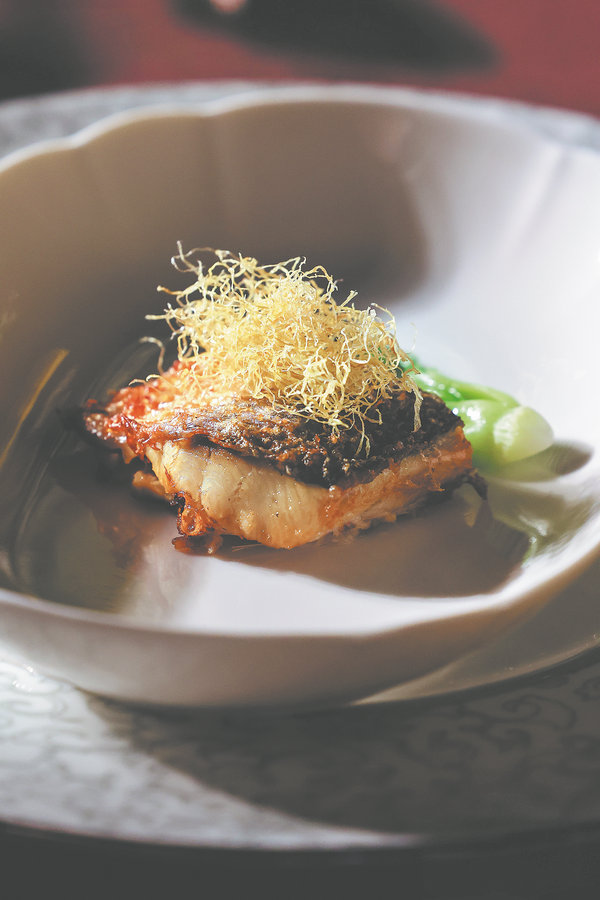
Delicacies inspired by depictions in the Chinese novel Dream of the Red Chamber and the life of Cao Yin, the grandfather of the novel's author, Cao Xueqin. Reeves shad fish. [Photo provided to China Daily]
For diehard fans of the household classic Dream of the Red Chamber, the lavish world of the Jia family offers more than just drama — it stirs culinary curiosity. Among the many delicacies described by novelist Cao Xueqin (1715-63), one stands out: qiexiang, a refined, preserved eggplant relish.
In the 41st of its 100 chapters, the sharp-witted noblewoman Wang Xifeng offers some qiexiang to Liu Laolao (granny), a poor, distant, elderly relative from the countryside.
Wang's description is both vivid and daunting: "Peel fresh eggplants, dice the flesh, and fry in chicken fat. Add finely chopped chicken breast, mushrooms, bamboo shoots, truffles, spiced tofu, and dried fruits. Simmer in chicken broth until dry, season with sesame and pickled sauce, then seal in a porcelain jar. To serve, mix with stir-fried diced chicken."
Liu is astounded and sticks out her tongue. "Heavens, it must take a dozen chickens just to make this — no wonder it tastes so extraordinary!"
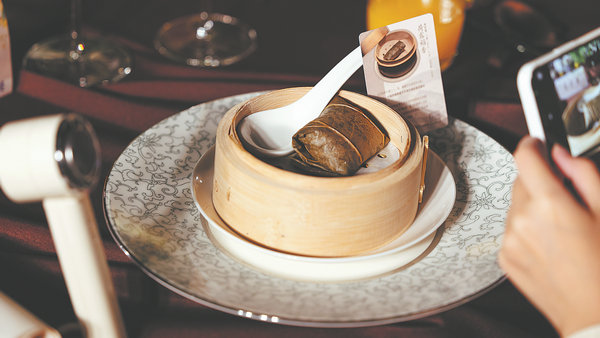
Delicacies inspired by depictions in the Chinese novel Dream of the Red Chamber and the life of Cao Yin, the grandfather of the novel's author, Cao Xueqin. Fried rice wrapped in a lotus leaf. [Photo provided to China Daily]
Yet, it is precisely this extravagance that has made readers crave qiexiang. Recently, the dish was brought to life by food historian and cultural scholar Lu Ran as part of the Ideas project, an initiative launched by Tencent News to help aspiring individuals bring their good ideas to fruition.
Lu first conceived the idea of re-creating the delicacies from the classic novel in 2019 while working on a research program about the seasonal food traditions of the Cao family. The family's rise began with the author's great-grandfather, Cao Xi, and peaked with his grandfather, Cao Yin, whose mother served as the wet nurse of Emperor Kangxi during the Qing Dynasty (1644-1911) and who was a study companion to the emperor.
Surprisingly, one of Lu's most important reference texts is not the novel itself, but Lian Ting Ji, a collection of Cao Yin's literary works, including 730 poems and 23 essays, some of which offer glimpses into his personal life, social circles, and culinary tastes.
"Cao Yin was a close childhood friend of Kangxi. As the emperor's study companion in the palace, he received a rigorous literary education. That training allowed him to capture the nuances of fine food in his poetry," Lu explains to China Daily.
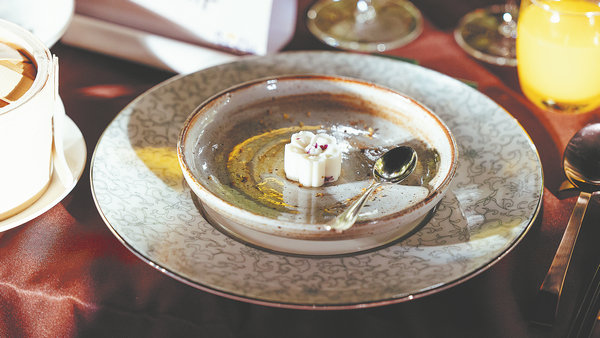
Delicacies inspired by depictions in the Chinese novel Dream of the Red Chamber and the life of Cao Yin, the grandfather of the novel's author, Cao Xueqin. Chinese yam cake. [Photo provided to China Daily]
A known bibliophile, Cao Yin befriended many scholars and copied valuable texts from their collections. Among them were the culinary techniques from earlier dynasties, which he compiled into a book titled Ju Chang Yin Zhuan Lu. It preserved the ancient recipes and cooking methods for various dishes, such as porridges, rock candies, preserved meats, and fermented fish.
Beginning with the death of his grandfather and followed by that of his father, Cao Xueqin's family fell from grace. This was caused by Emperor Yongzheng, Kangxi's successor, who confiscated the family's property due to complicated reasons involving corruption and their closeness to his former political rivals.
When misfortune struck, Cao Xueqin was just 13 years old. Around seven years later, he began writing Dream of the Red Chamber.
When Lu delved into the history of the Cao family and attempted to re-create the delicacies described in the novel, he discovered an intriguing fact — the dishes cooked according to Cao Xueqin's instructions did not turn out very well, nor did they taste good.
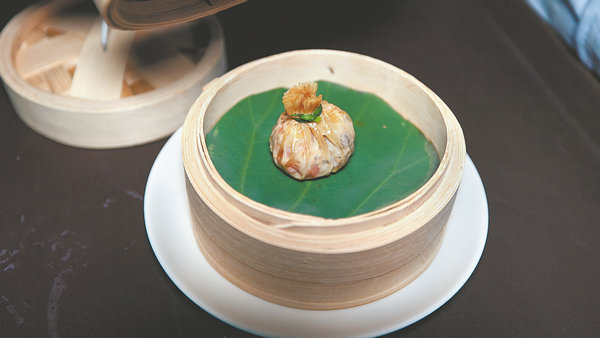
Delicacies inspired by depictions in the Chinese novel Dream of the Red Chamber and the life of Cao Yin, the grandfather of the novel's author, Cao Xueqin. A steamed bun wrapped in tofu skin. [Photo provided to China Daily]
"After all, Cao Xueqin was the young master of the Cao family, not its chef. The eggplant relish that Granny Liu enjoyed was a literary embellishment by Cao Xueqin. If one were to strictly follow the description in the book, the flavors would fail to penetrate the eggplant, and the result would likely be bland and unappetizing," explains Lu.
Yet, this is also the most meticulously described dish in the novel, which has "misled" the fans who attempt to re-create it.
Lu's approach was more academic. He discovered a recipe collection created during the era of Emperor Qianlong, grandson of Kangxi, which contains instructions for making eggplant relish. Although the method differed from the description in Cao Xueqin's novel, the taste was much better.
By cross-referencing historical texts with the help of a renowned Hangzhou chef, in Zhejiang province, Lu and his team from Tencent News' Ideas program successfully re-created nine dishes, debuting them at a late-September banquet in the Unique Dream of Red Mansion theatrical complex in Langfang, Hebei province. A dancer wearing ancient Chinese attire performed a graceful routine to a live pipa (four-stringed Chinese lute) melody, enriching the cultural atmosphere of the banquet.
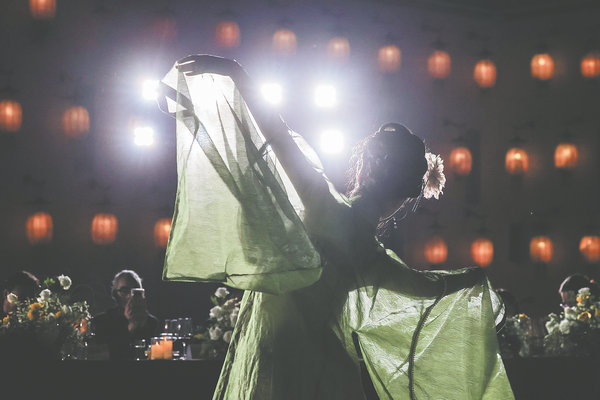
A dancer performs to a live pipa (a four-stringed Chinese lute) melody, enriching the cultural atmosphere of the banquet full of delicacies inspired by Dream of the Red Chamber and the life of the Cao family. [Photo provided to China Daily]
The recreated dishes are mostly sourced from pivotal or cozy scenes from the novel. For example, the protagonist, Jia Baoyu, craves one dish while recuperating from a severe beating by his father — a delicate soup made of water shield and lotus leaf-shaped dough slices simmered in chicken broth. Another was a simple snack he was longing for during a conversation with his maid, Qingwen — steamed buns wrapped in tofu skin. The menu also features a hearty dish of ham-stewed pork hock, given by the character of Wang to her husband Jia Lian's wet nurse.
There is one dish, however, that is unrelated to the novel but rooted in Cao Yin's real-life experience: pickled reeves shad fish (also known as shiyu). As an official responsible for procuring items for the imperial palace, Cao was tasked with transporting reeves shad fish to Emperor Kangxi.
Although the fish's flesh is exceptionally tender and delicious, it dies almost immediately after leaving the water. Therefore, it either had to be preserved before being shipped to Beijing or sealed in water-filled containers and rushed along the Grand Canal to the capital within a week.

Lu Ran, a food historian and cultural scholar, shares his ideas on how to re-create delicacies from the Chinese classic. [Photo provided to China Daily]
"Reeves shad is delicious, but it has many bones. When we prepare the dish, we take special care to remove all visible bones and pour hot oil over the scales to soften them. Being able to enjoy fresh shad in the northern regions today is, in a way, a modern luxury that lets us share in the delight Emperor Kangxi once experienced," Lu remarks humorously.
For Lu, a 44-year-old scholar previously focused on the Song Dynasty (960-1279) food culture, re-creating dishes from Dream of the Red Chamber is about more than cuisine. It is an experiment in using banquet as a "language" to express his unique understanding of the classic novel and the food culture of the early Qing Dynasty, from the Kangxi to the Qianlong eras.
According to Tencent News, they have encouraged Lu to expand his re-creations into a full banquet, hoping it will provide a model for a modern approach to studying classics, connecting contemporary readers with the past to help preserve traditional culture.
 Editor:Cai Xiaohui
Editor:Cai Xiaohui